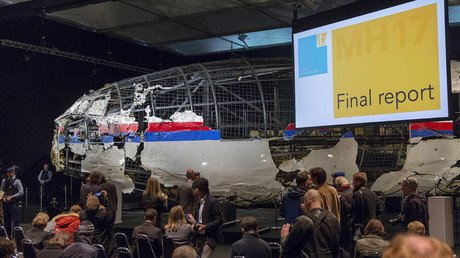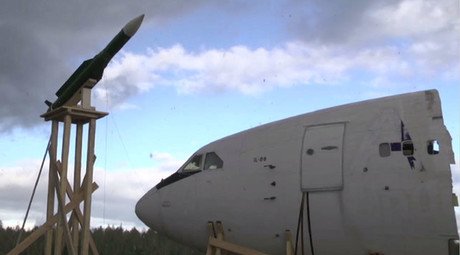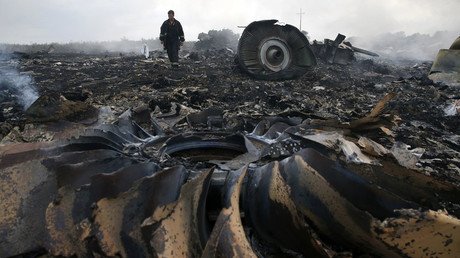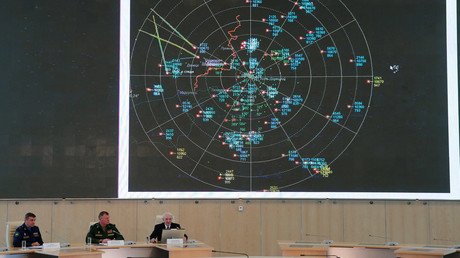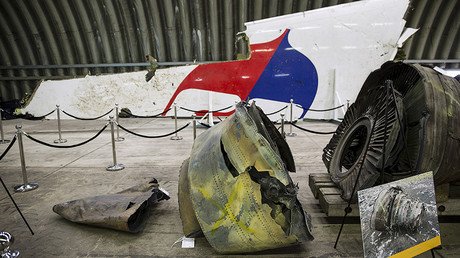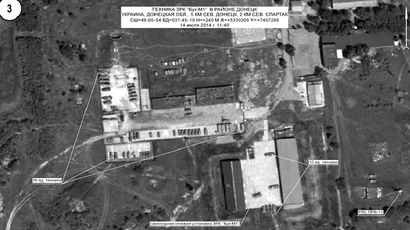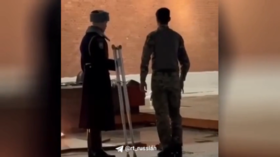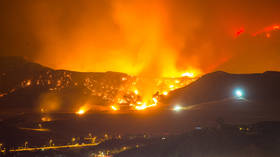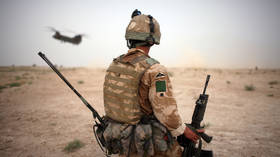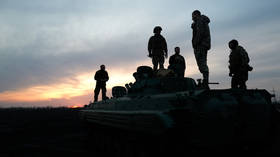MH17 tragedy: What we know on eve of int’l investigation team report
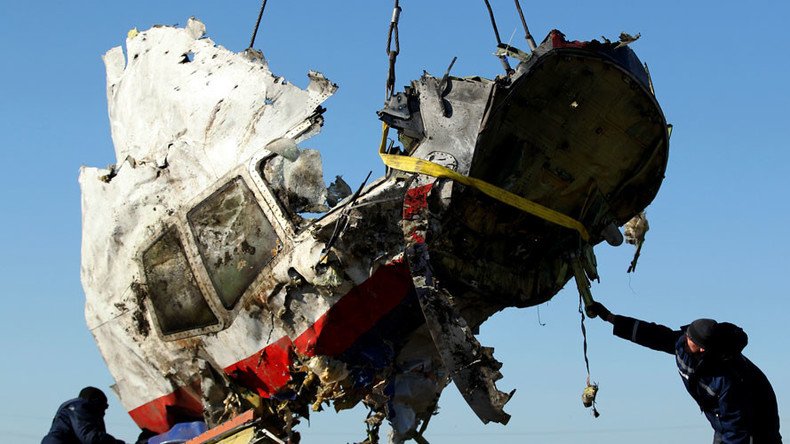
The first official results of the Joint Investigation Team’s investigation into the downing of the MH17 over eastern Ukraine in 2014 will be unveiled on Wednesday. RT takes a look at what we know so far.
Malaysia Airlines Boeing-777 flight MH17 left from Amsterdam for the Malaysian capital of Kuala Lumpur on July 17, 2014. The airliner was shot down over the war-torn Donetsk region in eastern Ukraine. All 298 people on board, from 10 countries, were killed, 80 children among them.
The plane was directed by Ukrainian air traffic control to fly over the armed conflict zone, where Ukrainian government forces had been battling rebels, opposing a coup-imposed government in Kiev. By July 2014, Kiev had lost at least 16 military aircraft in the crackdown, including two that went down just days prior to the MH17 tragedy. The airspace, however, had not been closed to civilian flights.
There are two official probes into the MH17 disaster - a technical inquiry led by the Dutch Safety Board, and a separate criminal investigation by the Joint Investigation Team (JIT). It consists of investigators and experts from the Netherlands, Belgium, Australia, Malaysia and Ukraine, and is set to determine who was responsible for the incident.
Dutch Safety Board report
The biggest public report to come out on the downing of MH17 so far was released by the Dutch Safety Board (DSB) in October 2015. According to the DSB’s findings, the Boeing 777 was shot down by a Buk missile with a 9N314M warhead. The Dutch experts were unable to determine which side in the conflict – the Ukrainian government forces or the rebels – was responsible for firing the missile. At the same time the 279-page report, which focused on the technical details connected with the incident and their implications for flying over conflict zones, stressed that the aviation authorities “did not adequately recognize the risks of the armed conflict in the eastern part of Ukraine to overflying civil aviation,” adding that there was “sufficient reason for closing the airspace above the eastern part of Ukraine as a precaution.” The DSB report provided no explanation for Ukraine’s failure to close the airspace over the conflict zone.
Buk producer experiment
Two unprecedented large-scale experiments, conducted by the Russian Almaz-Antey defense company in order to recreate the MH17 tragedy, concluded that the missile that downed the flight was an old model last produced in the Soviet Union in 1986 and fired from a Ukraine-controlled area, contesting the theory by Dutch investigators.
The Dutch investigators said the missile came from somewhere within a 320 square kilometer area within eastern Ukraine, which would mean it could not establish the side of the conflict which had controlled that launch site. Meanwhile, the experiment conducted by Almaz-Antey (the producer of the Buk missile system) reportedly demonstrated that the aircraft could only have been hit by a Buk missile if it had come from the village of Zaroshchenskoye in Ukrainian military-controlled territory.
Joint Investigation Team comments from June
Malaysia Airlines flight MH17 could have been downed “unintentionally,” a preliminary report by the Joint Investigation Team (JIT) said in June, adding that experts working on the case often lack the experience and data needed. “An important question for the criminal investigation is whether a missile can be launched unintentionally. Did anyone accidentally push a button which caused the missile to be launched? Or can this only be done by means of a conscious act?” reads a JIT report, published on the Dutch Public Prosecution Service’s website. The Dutch report gives no answers, complaining that it is often hard to find the relevant information while the investigators involved in the enquiry are simply “untrained” for dealing with such issues.
New radar data
Newly discovered raw data picked up by a civilian radar station on the day of the Malaysia Airlines flight MH17 crash shows no signs of a missile being fired at the plane from territory controlled by rebels, the Russian military and radar producer Lianozovsky Electromechanical Plant reported earlier this week. The plant is the producer of the Utyos-T civilian radar station and one such station is deployed near the village of Ust-Donetsky in western Russia.
The data showed three civilian aircraft in the vicinity, including the MH17. The one closest to it was flying about 30km from the Malaysian Boeing at the time it was shot down. “The Ust-Donetsky radar picked up no foreign objects near the Malaysian plane which could have caused its destruction,” said Viktor Meshcheryakov, the company’s deputy chief radar designer. This contradicts the scenario maintained by Kiev, in which a Buk missile could have been fired from the rebel-controlled village of Snezhnoye. The missile could have not been picked up by the radar if it had approached from a direction along the line connecting the radar station and the airliner, Meshcheryakov noted.
Gen. Andrey Koban, head of the Russian Air Force radar troops, said that “the fact that Ukraine has not published radar data leads us to the conjecture that the missile, if it was a Buk, was launched from territory under the control of the Ukrainian military.”
Blame game
Ukraine and its foreign sponsors accuse Russia of arming and supporting the rebels, an accusation that Moscow denies. Amid the hostilities, Kiev regularly accused Russia of invading Ukraine, claiming that it could not seize control of its eastern territory because of the Kremlin’s fighter jets, tanks, and multiple rocket launchers.
Almost immediately after the MH17 was downed, Western media and some governments blamed Russia, claiming Moscow had either provided the Buk system to the rebels or sent its regular troops to take down Ukrainian warplanes on their behalf.
In response to the accusations, Moscow has demanded that a thorough investigation be carried out and suggested plausible scenarios that contradict the Western narrative. It has also challenged Kiev’s claims that Ukraine had neither warplanes nor Buk systems in the area by producing public satellite and radar images showing evidence to the contrary. While the US claims to have evidence proving the rebels’ complicity, that data, if it does indeed exist, has never been declassified or shared with the public or investigators.
Activists’ analysis
The mystery behind the MH17 crash has prompted many to launch their own investigations. Among them was British online investigative activist group Bellingcat, which tried to prove that the Malaysian Boeing was shot down by a Buk missile system belonging to the Russian Army. It also accused Russia of altering satellite images from the MH17 disaster.
German image forensics expert Jens Kriese criticized their methods and conclusions. “What Bellingcat is doing is nothing more than reading tea leaves. Error Level Analysis is a method used by hobbyists,” Kriese, a professional image analyst and former scientific researcher, said.
This month, a group of Russian activists also released what they say is a fresh batch of discrepancies spotted in Bellingcat’s MH17 investigation.
